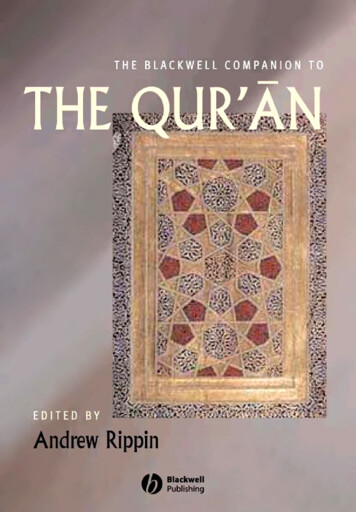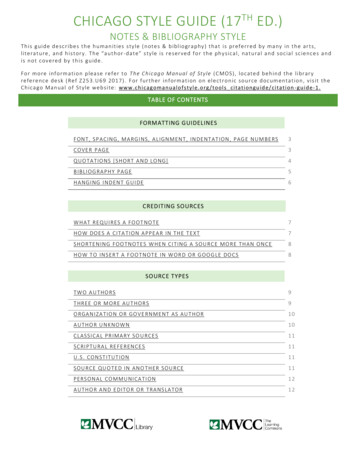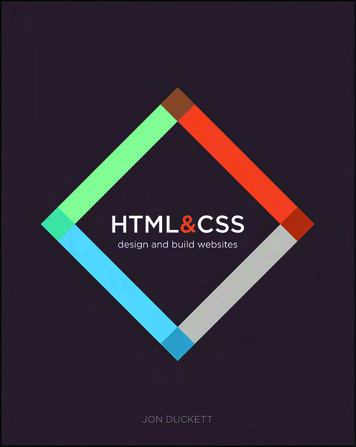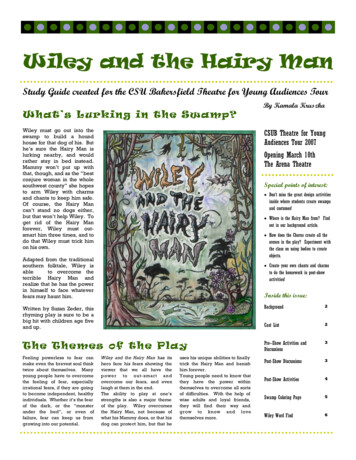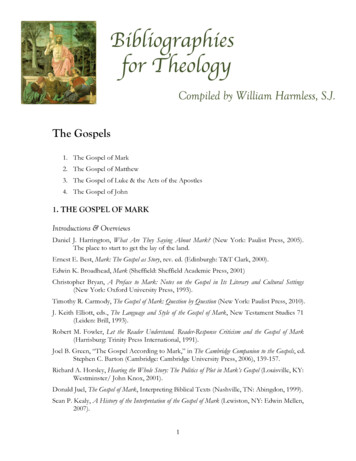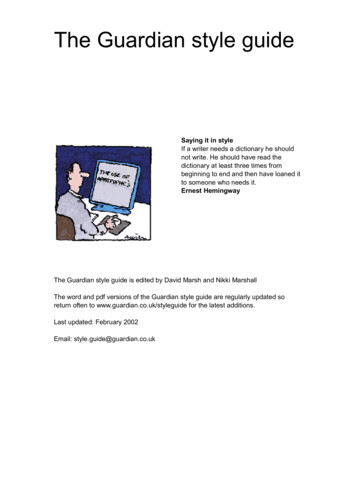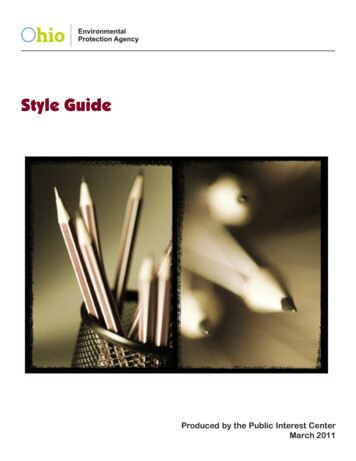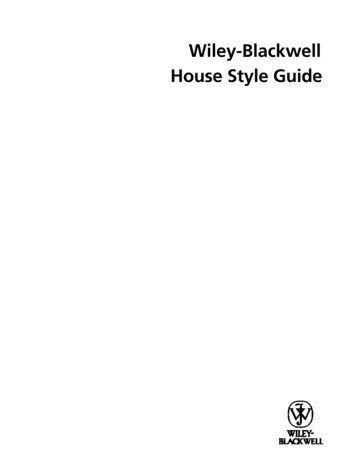
Transcription
Wiley-BlackwellHouse Style Guide
2007 John Wiley & Sons LtdAll rights reserved. No part of this publication may be reproduced,stored in a retrieval system, or transmitted, in any form or by anymeans, electronic, mechanical, photocopying, recording or otherwise,except as permitted by the UK Copyright, Designs and Patents Act1988, without the prior permission of the publisher.
3I N T R OD U C TI O N , 4PA R T .151.161.171.181.19Copy-editing, 5English Usage and Grammar, 5Editing for Sense, 10Spelling, 13Punctuation, 15Units, 19Italics, 21Quotations, 22Lists, 22Footnotes, 23Abbreviations, 24Time, 26Special Characters, 27Computing Terms, 28Currency, 28Qualifications, 28Organizations, 30Places, 30URLs in Text, 33PA R T 2:2.12.22.32.42.52.62.72.8D E A L I N G W I TH O T H ER M AT ER I A L , 34Electronic Submission, 34Disks, 34Artwork, 34Tables, 35References, 37Commercial Products, 39Permissions, 40Appendices, 40PA R T 3:3.13.23.33.43.53.63.73.83.93.103.113.12G E N E R A L ED I T I N G ST Y L E, 5S U B J E C T-S PE C I F I C S T YL E S, 4 1Scientific Names, 41Aquaculture and Veterinary Science, 43Linguistics, 44Business, Economics, Maths and Statistics, 44Computing and Engineering, 46Law, 46Life and Physical Sciences, 47Medicine, 50Nursing, Health and Dentistry, 56Social and Behavioural Sciences, 57Resources for Journal Abbreviations, 58Recommended Reference Books, 58Acknowledgments, 60 2007 John Wiley & Sons Ltd
4INTRODUCTIONThe Wiley-Blackwell Publishing House Style Guide and its online version have been produced forthe use of editors, production editors, freelances, copy-editors, authors and typesetters. The levelof consistency that this guide promotes is intended to assist all those involved in the productionof Wiley-Blackwell (WB) publications. The WB definition of copy-editing is best described astechnical or mechanical editing, which involves language editing, mechanical style (style related tocontent) and format (visual style). Technical or mechanical editing includes applying house style,technical style, formatting, consistency and correcting grammar. Creative or substantive editing isnot usually within the remit of the WB copy-editor and is not commented upon. This guide is notintended to be a comprehensive account of all that is necessary for the presentation of researchmaterial, and should be used in conjunction with texts that have greater scope (see recommendedreferences). Some journals and subject areas employ their own systems and conventions and theintention is not to impose upon them a rigid style, but rather to establish a framework withinwhich they can operate.The online version of this guide, available at www.blackwellpublishing.com/housestyle, willbe updated on a regular and on-going basis and should be regarded as the definitive version. Aseparate guide is available for US journals.Printed by The Charlesworth Group, Huddersfield, UK. 2007 John Wiley & Sons Ltd
5PA RT 1 : G E N E R A L E D I T I N G S T Y L E1.1 Copy-editingJournals and articles vary in the amount of editing required, depending on the thoroughnessof the editor and the standard of the text supplied. Copy-editing usually involves: applying journal style applying Wiley-Blackwell house style where no specific journal convention exists formatting text making text consistent correcting English to ensure the article is readableS TY L E A N D F O R M AT T I N GCheck your journal style sheet for the styles of authors’ names, addresses and affiliations,correspondence details, keywords, table and figure captions, etc., and for the formatting of text(e.g. use of small text in some sections).CONSISTENCYThe following should all be used consistently: UK/US spellings, alternative spellings, grammar,punctuation, italics, Greek letters, diacritics, hyphenation, capitalization, abbreviations andcontractions. References and their citations should be consistent and complete. Make sure that allfigures and tables are present and match their legends, and that they are cited in order.C O R R E C TI O N OF E N G L I SHYou may need to correct spelling, punctuation, grammar and syntax, and to edit for sense. If text isambiguous, add a query to the author asking for clarification. Do not rewrite or delete largesections of text.1.2 English Usage and GrammarVOICEThe tendency to present scientific text in the passive voice is fading. Most Wiley-Blackwell journalsand readers now accept use of the active voice. Unless the journal has a strict requirement for theactive or passive voice, follow the authors’preference, as long as this is consistent within themanuscript.Be wary of the passive voice in the Discussion, as it can sometimes be unclear whether the authorsare talking about their own work or that of other people. You may need to use phrases such as ‘inthe present study, it was found that ’ to clarify this.TENSEMethods used and results obtained by the authors should be referred to in the past tense: mice were given two types of grain mice in group A ate 50 mg of grain 2007 John Wiley & Sons Ltd
6The past tense will therefore generally be employed in the Abstract, Methods and Results sections.The past tense should also be used to talk about specific findings of previous work: Smith (1990) found that yield decreased by 50%Interpretation of results should be in the present tense: the results for groups A and B are significantly differentThe present tense will therefore generally be employed in the Introduction (except, for example,when the authors are stating what their hypothesis and aims were before the study commenced).The present tense should also be used in the Discussion when the results are being interpreted: Our study shows that a significant number of Finnish people speak FinnishFindings of previous studies should also be referred to in the present tense if they have becomegenerally accepted ‘facts’: treatment X results in Y, as demonstrated by Jones (1978) the expression of class I genes varies amongst haplotypesWatch for mistakes in the use of tenses in manuscripts from non-native English speaking authors(native English speakers tend to use the correct tense instinctively).S U B J EC T A N D V ER B A G R E E M EN TVerbs must agree in number with the sense and form of the subject. Check whether a noun is pluralor singular and make sure that the verb agrees. Collective nouns, e.g. school, number, family and committee, usually take singular verbs butcan take plural verbs if the emphasis is on the individual rather than on the unit itself, e.g. thecommittee has agreed to extend the deadline; the committee have been at odds from the beginning. Note the difference between mass nouns (which do not have countable elements) and countnouns (which identify things that can be counted), when used with pronouns (all, any, none,some), e.g. some of the sky was visible; some of the stars were visible. Units usually take singular verbs, e.g. 150 mL of blood was sampled. Take care with Latin and Greek nouns such as data, media, errata, criteria and phenomena,which are plurals; singulars are datum, medium, erratum, criterion and phenomenon (anexception is data processing): data are presented; dual-medium filters were used; twophenomena were classified using one criterion.U S E O F T H AT A N D W H I C HThat is used for defining or restrictive clauses: The patient made a list of the symptoms that were most troublesomeA defining clause is specific (limiting) to a particular person or thing; i.e. the patient had to listonly those particular symptoms that were most troublesome.Which is used in nondefining or nonrestrictive clauses: The patient made a list of the symptoms, which were most troublesomeA nondefining clause is general (nonlimiting); it provides additional information, and the use ofcommas is often important. In this example, all the symptoms were very troublesome. 2007 John Wiley & Sons Ltd
7D A N G L I N G PA RT I C I P L E SThese frequently occur where the passive voice is used, and they can link an action to an agent thatis incapable of performing it. The clause ‘the ribosomes could be observed using a microscope’should be reworded: ‘the ribosomes were observed by using a microscope’ or ‘using a microscope,the ribosomes were observed’.REDUNDANCYAvoid using a modifying word when the intended meaning is inherent in a word already used.Redundancy is obvious in examples such as the results were plotted graphically, past history, brightblue in colour, inactivates its activity and completely filled. Does the term careful monitoring suggestthat the alternative is careless monitoring?D E F I N I TE A N D IN D EF I N I T E A RT I C L E SMany non-native English speaking authors have some confusion about when to use the definite(the) and indefinite (a and an) articles. to determine effect of the salinity on grain yield of wheat to determine the effect of salinity on the grain yield of wheatAlso be aware that use of definite and indefinite articles in titles can differ from that in ordinarytext: Effect of Salinity on Grain Yield of WheatSee the recommended usage guides for guidance on the use of the indefinite article with wordsbeginning with ‘h’ (e.g. a hotel; an hour).I N A C C U R AT E P H R A S ESBe accurate in your word choice. For example, dose is the amount of drug given at one time;dosage is the regulation or determination of doses.U S E O F ‘ O N LY ’The position of the word ‘only’ can lead to ambiguity, e.g.‘the doctor only sees patients in themorning’ could mean ‘only the doctor sees patients in the morning’; ‘the doctor sees patients in themorning only’, or ‘the doctor sees only patients in the morning’.B A L A N C I N G A S E N TE N C EIt is important to ensure that a sentence balances on either side of certain words (correlatives) thatemphasize similarity or contrast and that are used in parallel: both and and; either and or; neitherand nor; not only and but; between and and; whether and or. For example,‘I swam both in themorning and afternoon’ should be‘I swam both in the morning and in the afternoon’ or ‘I swam inboth the morning and the afternoon’. Note the position of the preposition in. (See also the section‘Editing for Sense’.) 2007 John Wiley & Sons Ltd
8C O M PA R AT I VE S A N D S U P ER L ATI V ES If you are comparing two things, or two groups of things, or one thing with a group of things,you should use a comparative, not a superlative. Jim is tallest compared with David, John and Mike Jim is the tallest of the four men Jim is taller than David, John and Mike Do not use ‘relatively’ with a comparative, e.g. relatively less. This is tautology; ‘relatively’should be deleted. Make sure that it is clear what is being compared with what (e.g.‘in patient 3, there was greaterreactivity for P. gingivalis in dental plaque from the first molar’ Is‘greater’ being used tocompare patients, bacteria or sites in mouth?).M I S C EL L A N EO U S PO I N TS‘Male’ and ‘female’ are adjectives, so be careful to use them as such (i.e. a male patient and a femalefrog, but a 35-year-old man, a French woman and a group of 25 men and 35 women). Many authorsget this wrong.E XP R ES S IO N S TO AV O I D Since should be used only with reference to time, and not for because.Although is preferred to though.Done, as in the experiment was done, should be replaced with performed or carried out.Parameter should only be used to describe a defining limit, and is not interchangeable withvariable.A lot of should be replaced with many or, preferably, should be defined more precisely.Avoid get and got.As a result of or because of are preferred to due to.Hopefully should be avoided.Try to avoid references in the text to see below or in the Results section.Use dependency only for foreign territories; otherwise use dependence.U S E W I TH C A U TI O NBe aware of potentially litigious content, for example the naming of patients or criticism of theactions of individuals, organizations or companies.P O L I T I C A L LY S EN S I TI V E T ER M SRace and ethnicityTry to avoid the terms Blacks and Whites; use instead Black people, White people, etc. Caucasian,Mongoloid, Negroid, etc. are generally to be avoided, except in human population studies. Mixedrace is preferable to half-caste or coloured.Disabilities People with disabilities not the disabled People with learning difficulties not mentally handicapped 2007 John Wiley & Sons Ltd
9GenderUse neutral nouns: avoid the use of man if not specifically referring to men; for example, for manuse humans; for mankind use the human race; for manpower use workforce; for manmade fibre usesynthetic fibre. Use inclusive pronouns: use he or she, or rephrase the sentence (rephrasing to theplural form often works): Any observer of changes in publishing technology will perceive that he has need of Observers of will perceive that they have Beware of referring to people with stereotypical pronouns (e.g.‘the doctor treated his patient’;‘thesecretary tidied her desk’). Social classes and age groups should also not be stereotyped.DiseaseAvoid health-determined categorization. Use people with diabetes not diabetics; people with cancernot cancer sufferers, etc. Avoid phrasing that dehumanizes a patient: many authors use case(instance of a disease) when they mean patient (person who is ill with the disease).AIDS Ensure that AIDS is used for the disease and HIV for the virus, e.g. do not use AIDS carrier,AIDS positive, AIDS virus or catching AIDS. AIDS sufferer/victim is inappropriate; use people with AIDS. People who practise high-risk activities not high-risk groups. The expression full-blown AIDS is unnecessary if the correct distinction has been madebetween HIV and AIDS.SexualityAvoid the terms homosexual activities (specify which activity is being referred to) and homosexuals(specify homosexual men or lesbians).GeographyThe terms Third World, poor countries and underdeveloped countries should be avoided. Developingor nondeveloped country/society is better, but it is best to specify countries or regions instead.Western society and Western World should only be used in relation to geography; otherwise, usedeveloped world/society or, even better, specify the countries themselves or the region.Key points It is now acceptable to use the active or the passive voice. Use the past tense for the author’s methods and results, and the present tense forinterpretation and generally accepted ‘facts’. The subject and verb must agree in number. ‘That’ is defining; ‘which’ is not. Check that articles (‘a’,‘an’ and ‘the’) are used correctly. Sentences must balance (e.g. with ‘both and ’). In comparisons (e.g. with lower/higher/less/more), make sure it is clear what is beingcompared with what. Avoid sexist, dehumanizing and stereotypical language. 2007 John Wiley & Sons Ltd
101.3 Editing for SenseYou do not need knowledge of the subject matter to be able to edit for sense. Often it will beobvious what the author is trying to say, in which case you do not need to add a specific query (e.g.‘with this investigation the effects of antibiotic treatment were inquired’ can safely be changed to‘in this investigation, the effects of antibiotic treatment were investigated’). However, if you arehaving to make substantial changes, add a query to the beginning of the article telling the authorsthat text has been reworded throughout and asking them to check carefully.Be very careful not to change the meaning. It should always be your goal to make only the changesthat are necessary. If in doubt, leave unchanged and ask the author for clarification.A M B IG U O U S T EX TWhen text is ambiguous, the intended meaning is sometimes obvious from the context andrewording is straightforward. If this is not the case, you must query the authors. It is best, if youcan, to give them two (or more) choices rather than just asking what they mean.Phosphorylated hexoses: glucose-6-P and fructose-1-P, repress the expression of many resistancegenes.Query Do you mean ‘Phosphorylated hexoses, such as glucose-6-P and fructose-1-P, repress the expression ofmany resistance genes’ or ‘The phosphorylated hexoses glucose-6-P and fructose-1-P repress the expression ofmany resistance genes’ or something else?Misplaced modifiers (words or phrases that limit or qualify the sense of text) can create ambiguityabout what they are modifying. She continued editing after the meeting finished early because she had to send the issue to thetypesetter Because she had to send the issue to the typesetter, the meeting finished early and she continuedediting After the meeting finished early, she continued editing because she had to send the issue to thetypesetterN O N SE Q U I TU R SLook out for text that does not logically follow what goes before (e.g.‘humans and mammals ’should be changed to‘mammals, including humans, ’ because humans are mammals). Forage turnip is widely grown in northern Europe, but it is distributed over much ofnorthern Asia, northern North America and southern Oceania. Forage turnip is widely grown in northern Europe and is also distributed Sometimes it is not clear what the author means to say.The sensitivity of barley seedlings changed after 4 weeks of cold treatment, but decreased after 6weeks.Query Do you mean ‘The sensitivity of barley seedlings began to decrease after 4 weeks and decreased furtherafter 6 weeks’ or ‘The sensitivity of barley seedlings increased after 4 weeks . but decreased after 6 weeks’?These results are in conformity with the results of Smith et al. (1984). This provides acidproduction in vitro observed over a period of time by Jones (1980) also. 2007 John Wiley & Sons Ltd
11Change These results are consistent with those of Smith et al. (1984). They also provide an explanation for theacid production in vitro observed over a period of time by Jones (1980).Query ‘These results ’ Rewording of two sentences OK?B A L A N C I N G SE N TE N C E SUse parallel grammatical constructions with conjunctions (and, but, etc.) and in comparisons. the titre in week 2 increased by 50% for patient 1, and by 60% for patient 3 in week 4 the titre increased by 50% for patient 1 in week 2, and by 60% for patient 3 in week 4 to evaluate the relationships between clinical (e.g. stroke impairment, functional status,depression, and side of stroke lesion) and sociodemographic (e.g. age, gender, marital statusand emotional support) factors to evaluate the relationships between clinical (degree of stroke impairment, functionalstatus, presence/absence of depression and side of stroke lesion) and sociodemographic (age,gender, marital status and extent of emotional support) factors Detection of immunostained proteins by light microscopy is not as clear as electronmicroscopy Detection of immunostained proteins by light microscopy is not as clear as that by electronmicroscopyPRONOUNSWatch out for pronouns that refer back to the wrong noun.The pellet was dissolved in 100 mL of distilled water. It was then filtered through Whatman no. 41paper.Change ‘It’ to e.g.‘This solution’ (‘the pellet’ can’t be filtered!).FEWER/LESSAlthough more can be used for both countable (e.g. more stars) and uncountable (e.g. more rain)nouns, fewer must be used for countable nouns (e.g. fewer stars, fewer cups of tea, fewer examples)and less for uncountable nouns (e.g. less rain, less tea, less information). Less people Fewer peopleS TR O N G / W E A K , H I G H / L O W A N D L A R G E / SM A L LAuthors sometimes make the wrong choices here. the values of r were strong the values of r were high there was a low correlation there was a weak correlation 2007 John Wiley & Sons Ltd
12M I S C EL L A N EO U S PR O B L E M S Words missingThe sorbitol and xylitol interaction on sugar metabolism was greater at higher pH.Change The effect of the sorbitol and xylitol interaction on sugar metabolism was greater at higher pH.In this study the relationship between plant resistance to fungi and some physiologicalprocesses.Change In this study, the relationship was investigated. Words wrongBarley companion crop reduced weed content of herbage by 39–94% related in sowing rateand cutting stage.Change The barley companion crop reduced the weed content of herbage by 39–94 % depending on theseeding rate and cutting stage. Strange wordingAll patients were examined and interviewed on a hospital basis.Change (and query) All patients were examined and interviewed in hospital. Wrong subject and verbHarvest date in barley gave different effects depending on seeding rates.Change (and query) In barley, the effect of harvest date depended on the seeding rate. Adjective with wrong nounthe highest patient for recovery scoreChange (and query) the patient with the highest recovery score TyposThe weed forms its own pure colonies at the expanse of native gassesChange (and query) at the expense of native grassesKey points If text does not make sense or is likely to cause the reader problems, change it and, ifnecessary, add a query to the author. Look out for ambiguous text and non sequiturs. Make sure parallel grammatical constructions are used with conjunctions and incomparisons. Pronouns must refer back to the correct noun. Fewer/less, strong/high/low and weak/low/small are often used incorrectly. Check that subject/verb and noun/adjective pairs make sense (e.g. in ‘the highest patientfor recovery score’, the adjective has been attached to the wrong noun). 2007 John Wiley & Sons Ltd
131.4 SpellingSpelling should be consistent within an article. When two or more spellings of a word are given in adictionary, the first listed is generally the one preferred.UK/US ENGLISHIn the following examples, the UK spellings are shown to the left of the double arrows and the USspellings to the right.ae- e--ical -icaetiology etiologycaesium cesiumhaemoglobin hemoglobinleukaemia leukemiapalaeoenvironment paleoenvironmentanatomical anatomicbiological biologicgeographical geographicimmunological immunologic-logue -logoe- ediarrhoea diarrheadyspnoea dyspneamanoeuvre maneuveroedema edemaoesophagus esophagusoestrogen estrogen-lled -led, -lling -linglabelling labelingmodelled modeledanalogue analog(except ‘analog–digital conversion’)catalogue catalog-re -ercentre centerfibre fiberlitre litermetre (the unit) metertitre titer-yse -yze-our -orbehaviour behaviorcolour (but coloration) colorneighbour neighbortumour tumoradrenaline epinephrine (Adrenalin US trade name)ageing agingalternative alternatealuminium aluminumamongst amongcyclosporin cyclosporinedespatch dispatchdisc disk (NB always disk for computers)dysrhythmias arrhythmiasfulfil fulfillleucocyte leukocyte 2007 John Wiley & Sons Ltdanalyse analyzecatalyse catalyzedialyse dialyzelicence (noun) licensemould moldneurone neuronnoradrenaline norepinephrineorientate orientpractise (verb) practiceprogramme program (and UK for computers)quantify quantitatequantification quantitationskilful skillful
14S V ER SU S Z SP EL L IN GS isetelevisetreatiseZ estabilizestandardizesummarizetemporizevaporizeF O R EI G N L A N G U A G E SAccents and diacritical marksThese are marks attached to letters of the alphabet that show (i) how the pronunciation differsfrom that of the unmarked letter, (ii) where the stress falls in a polysyllabic word or (iii) what toneor pitch goes with a particular word. German Use ß (eszett) for ss, but only in lower case (and note that not all ss are ß); in caps(and small caps), SS is always used. Use umlauts over ä, ö and ü rather than using therespective diphthongs ae, oe and ue. Remember that, in German, all nouns have initial caps(e.g. ein Haus, das Sein) and they should retain these when italicized. French Upper-case letters carry accents, e.g. RÉSUMÉ. The exception is the preposition à,e.g. A la porte. Scandinavian characters should be alphabetized as follows: Z, Æ, Ø, Å (Danish, Norwegian) Z, π, Æ, Ö (Icelandic) Z, Å, Ä, Ö (Finnish, Swedish)Foreign namesTake care with the capitalization of particles in foreign names (e.g. Philippe Du Puy deClinchamps,Vasco da Gama, Vincent van Gogh). These appear in lower case except at the start of asentence or when the name is anglicized. Generally, just use what the author provides. In referencelists, lower case particles are listed under the letter of the name proper but upper case particlesunder the letter of the particle (e.g. da Silva under ‘S’ but Von Trapp under ‘V’). Do not abbreviate‘Saint’ and ‘Sainte’ in French surnames. Some Japanese and Chinese names are presented with thesurname first, so be careful when filing these in a reference list. Spanish and Portuguese names aresometimes composed of two family names (mother’s and father’s) and should be listed under thepenultimate element (e.g. Federico Gutierrez Granier should be listed under Gutierrez).Hyphenated Asian names do not take a full point after the first initial (e.g. Jen-Yi Hwang is J-Y.Hwang not J.-Y. Hwang; cf. Jean-Marc Lafayette, which is J.-M. Lafayette). 2007 John Wiley & Sons Ltd
15R E C O M M E N D E D SP EL L I N G G U ID ES UK spelling: Concise Oxford DictionaryUS spelling: Merriam-Webster’s Collegiate DictionaryAustralian spelling: Macquarie DictionarySee The Chicago Manual of Style for information on capitalization, punctuation and worddivision in foreign languages.1.5 PunctuationPunctuation should be used to help the reader understand the text.COMMASContextExamplesNot essential where a conjunction is used betweentwo clauses unless there is a change of subjectWe tried to resuscitate the patient but to no avail.Used to isolate a word, phrase or subordinateclauseResuscitation, although dangerous, is possible.Resuscitation is possible, but brain damage is likely.On revival, the patient was monitored regularly. days 3, 4 and 10, respectively.Therefore, the experiment was .Used to isolate nondefining clausesThe cells, which were infected, were excised.The commas help to isolate the nondefining clause(see differences between ‘that’ and ‘which’ above).Not used to separate sentences The cells produced more lactate, however theydid not produce acetate. The cells produced more lactate; however, theydid not produce acetate.Used in listsThe solution contained 200 mg of glucose, 100 g ofascorbic acid and 500 mL of distilled water.UK English: a comma before ‘and’ (known as theOxford comma or serial comma) is unnecessary inthe above example, but it may be used in lengthylists or to avoid ambiguity.US English: authors prefer to place a comma beforethe ‘and’ here.‘Therefore’ should not be enclosed within commaswhen used as an adverbThese samples were therefore discounted.Used to clarify a sentenceThe precipitate formed after shaking on the bottommakes more sense with the addition of commas,thus:The precipitate formed, after shaking, on the bottom. 2007 John Wiley & Sons Ltd
16A P O ST R OP H E S A N D P R I M E SApostrophes should be used to identify possessive nouns, e.g. the body’s defence system, the girls’hats. Such words ending in ‘s’ should still be followed with an apostrophe ‘s’, e.g. Claudius’s reign.An apostrophe should not be used where an acronym, abbreviation, date or number is pluralized:ANOVAs, 1980s, etc. Where apostrophes are used to indicate missing letters in informal English(e.g. I’m, we’re, he’s; it’s not clear; there’re many patients; it’s been found), it is usually preferable towrite the words out in full (e.g. it is not clear; there are many patients; it has been found).Look out for its (possessive; e.g. its tail) and it’s (‘it is’ or ‘it has’; e.g. it’s got a tail).St Thomas’ HospitalQueens’ College, CambridgeThe Queen’s College, OxfordPrimes ( ) are used to denote derivatives of mathematical variables (e.g. a and a ) and for minutesof angle (e.g. 12 14 N). They should not be used instead of the standard abbreviation ‘min’ forminutes of time.HYPHENSJournals will often have a specific hyphenation style, for which you should refer to your journalstyle sheet. Also check the relevant dictionary if necessary. Make a decision about hyphenationand apply it throughout the typescript, taking into account the author’s style, the likely readership,and the meaning of individual words and phrases. Minimal hyphenation is generally preferred.PrefixesDO hyphenate prefixes that stand as words in their own right (e.g. cross, half, all); these areusually hyphenated when used as adjectives (e.g. cross-section, half-life, all-inclusive). There are,however, more than a few exceptions (e.g. outpatient, crosshatched, overexposed). Hyphens arealso needed when a prefix is attached to a word or phrase starting with a capital letter (e.g. antiHLA, non-Euclidean, sub-Alpine).DO NOT hyphenate prefixes that cannot stand as words in their own right (e.g. anti, bi, co,hyper, hypo, infra, inter, intra, micro, multi, palaeo, peri, pre, pseudo, re, sub, supra, ultra, uni);these are usually closed up when used as adjectives, unless two vowels or the same consonants abutt(e.g. hyper-reactive, pre-operative, anti-inflammatory, co-opted, re-election; NB US authors areless inclined to use hyphens in such cases). Note, however, that this rule may need to be broken (e.g.ultra-high-vacuum environment, pseudo-first-order distribution, re-create). If in doubt, followthe author’s style.Compound termsDO hyphenate many compound terms and adjectives (e.g. iron-rich sediments; salt-leachedwater; 19-year-old boy but bo
The Wiley-Blackwell Publishing House Style Guide and its online version have been produced for the use of editors,production editors,freelances,copy-editors,authors and typesetters.The level of consistency that this guide promotes i
